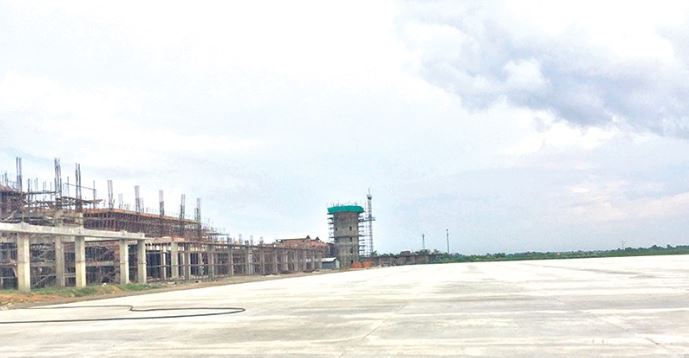BHAIRAHAWA: If things go according to the plan, there is a target of bringing Gautam Buddha International Airport into operation within the next six months and works are going on accordingly.
The airport is capable of welcoming Boeing 777 and aircraft of Airbus 330 series and if everything goes well, Boeing 777 jet aircraft and Airbus planes can easily operate from here, creating history in Nepal’s aviation sector.
It will serve as a reliable alternative to Tribhuvan International Airport.
The project is being implemented by the Asian Development Bank (ADB)’s loan and grants and OPEC Fund for International Development (OFID) and Nepal Government’s investment remains as the project of national pride.
Over 270 workers are working daily in two shifts to complete their physical works within the next one month. It is located in Bhairahawa, Rupandehi at an altitude of 105 meters above mean sea level.
The three kilometers long runway with 45 meters breadth has been already blacktopped and presently its marking is underway which will be completed next week.
The existing runway is 1,524 meters long and 30 meters wide and it will be used as a parallel taxiway after the airport comes into operation.
More than 85 percent of the physical infrastructures of the airport has been completed at present while works are being carried out in a rapid pace for painting and interior furnishing at the control tower, the international terminal building, apron, fire control and rescue building, the main powerhouse, arrival and departure terminal and the administrative building.
Works on diversion of the Ghaghara rivulet, construction of the car parking lot and drains have also been completed. A group of workers is engaged in constructing the garden at the airport and its beautification.
Supply, delivery, installation and commissioning of communication, navigation and surveillance (CNS)/Air Traffic Management (ATM) Equipment Meteorological Equipment and other related goods would be completed within three months.
Similarly, the construction of Airside and Landside Infrastructures and other facilities at GBA would be completed within that period.
The major work components under this package are the Airside Infrastructures at GBA including New Runway (3,000meters long x 45 meters wide and 7.5m shoulder), the overlay (100 cm) of existing Runway (1,500 meters x 23 meters) to be used as Parallel Taxiway, extension of 200 meters on both ends of the existing Runway, the Exit Taxiway System and relocation of Outer Diversion and Inner Periphery Roads.
The landside infrastructures at GBA include International Terminal Building (ITB), the International Aircraft Parking Apron, the Control Tower and Administrative Building, the Crash Fire and Rescue (CFR Building) and the Main Sub-station (Generator House).
The Korean company Yooshin Engineering Corporation is the consultant while the Northwest Civil Aviation Airport Construction Group, China is the contractor company.
Manager of the contractor company, Xu Bezing expressed the commitment that the project would be completed within the deadline.
“We are working together with helpful and understanding Nepali friends. There is no shortage of any construction materials. We have no problem between us and all the physical infrastructures would be constructed within the stipulated time,” he said, in a short conversation with RSS, with the help of a translator.
The project was implemented on December 31, 2014. The date of project completion was set for December 31, 2017, but was extended to 28 June 2019. The project completion date was revised again and set for December 30, 2019. It faced various problems before this and the main investor, the Asian Development Bank (ADB) withdrew from the construction of the airport.
The progress made in the construction of the physical infrastructures of Gautam Buddha International Airport is an outcome of the government’s firm determination to construct a second international airport at Bhairahawa by any means.
ADB provided loans and grants for the project following the government’s active role and request. ADB has provided a 40.5 loan and 18 percent grant while OFID has contributed 30.5 percent and the government the rest of the cost of the project.









Comment